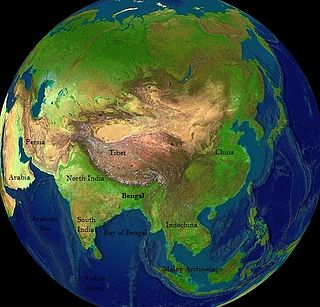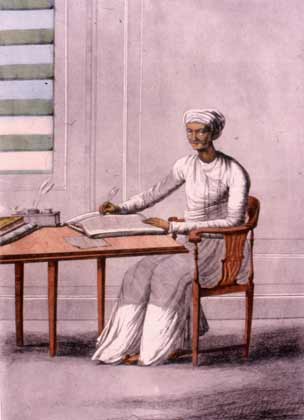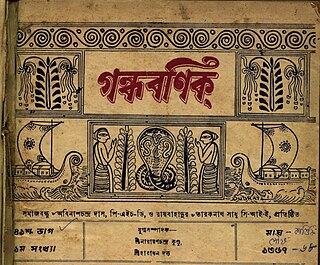Related Research Articles

Bengal is a historical geographical, ethnolinguistic and cultural term referring to a region in the eastern part of the Indian subcontinent at the apex of the Bay of Bengal. The region of Bengal proper is divided between the modern-day sovereign nation of Bangladesh and the Indian state of West Bengal.

Nathaniel Brassey Halhed was an English Orientalist and philologist.

Kayastha or Kayasth denotes a cluster of disparate Indian communities broadly categorised by the regions of the Indian subcontinent in which they were traditionally located—the Chitraguptavanshi Kayasthas of North India, the Chandraseniya Kayastha Prabhus of Maharashtra, the Bengali Kayasthas of Bengal and Karanas of Odisha. All of them were traditionally considered "writing castes", who had historically served the ruling powers as administrators, ministers and record-keepers.

Sonargaon is a historic city in central Bangladesh. It corresponds to the Sonargaon Upazila of Narayanganj District in Dhaka Division.

Bengali Brahmins are the community of Hindu Brahmins, who traditionally reside in the Bengal region of the Indian subcontinent, currently comprising the Indian state of West Bengal and the country of Bangladesh.
Chakraborty is a surname of Bengali Hindus and Assamese Hindus of India and Bangladesh, the surname is used by people of the Bengali Brahmin and Assamese Brahmin communities in States of West Bengal,Tripura and Assam.

Bengalis, also rendered as endonym Bangalee, are an Indo-Aryan ethnolinguistic group originating from and culturally affiliated with the Bengal region of South Asia. The population is divided between the sovereign country Bangladesh and the Indian regions of West Bengal, Tripura, Barak Valley, Goalpara, Andaman and Nicobar Islands, and parts of Meghalaya, Manipur and Jharkhand. Most speak Bengali, a language from the Indo-Aryan language family. Sub-section 2 of Article 6 of the Constitution of Bangladesh states, "The people of Bangladesh shall be known as Bengalis as a nation and as Bangladeshis as citizens."
Mahishya is a Bengali Hindu traditionally agrarian caste, and formed the largest caste in undivided Bengal. Mahisyas were, and still are, extremely diverse caste consisting of all possible classes in terms of material conditions and ranks.

The Bengal Sultanate (Middle Bengali: শাহী বাঙ্গালা, Classical Persian: سلطنت بنگاله was a late medieval sultanate based in the Bengal region in the eastern Indian subcontinent between the 14th and 16th century. It was the dominant power of the Ganges-Brahmaputra Delta, with a network of mint towns spread across the region. The Bengal Sultanate had a circle of vassal states in the Indian subcontinent, including parts of Odisha in the southwest, Arakan in the southeast, and Tripura in the east.

Bengali Hindus are an ethnoreligious population who make up the majority in the Indian states of West Bengal, Tripura, Andaman and Nicobar Islands, Jharkhand, and Assam's Barak Valley region. In Bangladesh, they form the largest minority. They are adherents of Hinduism and are native to the Bengal region in the eastern part of the Indian subcontinent. Comprising about one-third of the global Bengali population, they are the second-largest ethnic group among Hindus after Hindustani Hindus. Bengali Hindus speak Bengali, which belongs to the Indo-Aryan language family and adhere to Shaktism or Vaishnavism of their native religion Hinduism with some regional deities. There are significant numbers of Bengali-speaking Hindus in different Indian states. According to the census in 1881, 12.81 per cent of Bengali Hindus belonged to the three upper castes while the rest belonged to the Shudra and Dalit castes.
Sadgop, also spelled as Sadgope, is a Bengali Hindu Yadav (Gopa) caste. Traditionally they are engaged in cultivation. Since late mediaeval period Sadgops had established themselves as dominant political power in peripheral lateritic forest areas of Rarh region, now included in Birbhum, Burdwan and Midnapore districts. Karnagarh, Narajole, Narayangarh and Balarampur in Midnapore and several other zamindari estates in Burdwan, Hooghly, Birbhum belonged to them. As of late nineteenth century they were one of the fourteen castes belonging to 'Nabasakh' group.
Baishya Kapali is a Bengali Hindu agricultural caste found in the Indian state of West Bengal and in Bangladesh. From the 1960s, a section of the Kapali caste embraced 'Baishya Kapali' as their caste name, which remains a matter of dispute to date. The Kapalis have excelled in cultivating jute and the manufacture of gunny bags. Baishya Kapalis or Kapalis are listed as Other Backward Classes in West Bengal.

The Bengali Calendar or Bangla Calendar, colloquially, is a solar calendar used in the Bengal region of the South Asia. A revised version of the calendar is the national and official calendar in Bangladesh and an earlier version of the calendar is followed in the Indian states of West Bengal, Tripura and Assam. Unlike the traditional Indian Hindu calendar which starts with the month of Chaitra, the Bengali calendar starts with Boishakh because of the reforms made during the reign of the Mughal Emperor Akbar in Mughal Bengal. The first day of the Bengali year is known as Pohela Boishakh which is a public holiday in Bangladesh.

Gandhabanik is a Bengali Hindu trading caste, who as the caste name suggests, traditionally used to trade in perfumes, cosmetics, spices etc. They were also engaged in agriculture. As of late nineteenth century they were one of the fourteen castes belonging to Nabasakh group.
Baidya or Vaidya is a Bengali Hindu community located in the Bengal region of Indian subcontinent. A caste (jāti) of Ayurvedic physicians, the Baidyas have long had pre-eminence in society alongside Brahmins and Kayasthas. In the colonial era, the Bhadraloks were drawn primarily, but not exclusively, from these three upper castes, who continue to maintain a collective hegemony in West Bengal.
Aguri, also known as Ugra Kshatriya, is a Bengali Hindu agricultural caste or community found in the districts of Bardhaman, Birbhum, Hooghly, and Bankura in the state of West Bengal in India. Aguris are now considered as a middle-caste group and according to Gail Omvedt, constitute "more prosperous owner-peasants" among the peasant communities of Bengal.
Kansabanik or Kansari is a Hindu caste found from West Bengal, Odisha and Assam state of India. They are traditionally braziers and coppersmiths by profession. Kansabanik represents one of the fourteen castes belonging to 'Nabasakh' group in Bengal. Kanshabaniks are recognized as Other Backward Class by the Government of West Bengal.

Bengali Kayastha is a Bengali Hindu caste originated from the Bengal region of Indian subcontinent, and is one of the main subgroups of the Kayastha community. The historical caste occupation of Kayasthas throughout India has been that of scribes, administrators, ministers and record-keepers; the Kayasthas in Bengal, along with Brahmins and Baidyas, are regarded among the three traditional higher castes that comprise the "upper layer of Hindu society". During the British Raj, the Bhadraloks of Bengal were drawn primarily, but not exclusively, from these three castes, who continue to maintain a collective hegemony in West Bengal.
Suvarna Banik, also called Bene, is a Bengali mercantile caste dealing in gold and silver. During the late 18th century, merchants of the caste became prominent in trade. In spite of their inferior ritual rank, they were the most well known trading caste in Bengal region as per the 1951 Census of India.
Kundu is a common Bengali Hindu surname found among the Bengali Kayastha, Teli and some other communities of India and Bangladesh.
References
- ↑ Hashmi, Taj ul-Islam (1992). Pakistan as a Peasant Utopia. Taylor & Francis. pp. 35, 43, 105, 109, 111, 112, 148. ISBN 978-0-367-28215-8.
- ↑ Ganguly, Jibamitra (2019). Meghnad saha : his science and persona through selected letters and writings (PDF). INDIAN NATIONAL SCIENCE ACADEMY. p. 12. ISBN 978-81-939482-5-5.
- 1 2 "Saha". Banglapedia . Retrieved 29 January 2022.
- ↑ {{Cite book |last=Sengupta |first=Saswati |url=https://oxford.universitypressscholarship.com/10.1093/oso/9780190124106.001.0001/oso-9780190124106 |title=Mutating Goddesses: Bengal's Laukika Hinduism and Gender Rights |date=2021 |publisher=Oxford University Press |isbn=978-0-19-012410-6
- ↑ Sarma, Jyotirmoyee (1980). Caste Dynamics Among the Bengali Hindus. Firma KLM. p. 15. ISBN 978-0-8364-0633-7.
- ↑ "Saha". Banglapedia . Retrieved 29 January 2022.
- ↑ Sarma, Jyotirmoyee (1980). Caste Dynamics Among the Bengali Hindus. Firma KLM. p. 107. ISBN 978-0-8364-0633-7.
- ↑ "Bengal govt wary of implementing Mandal report,says OBC group". The Indian Express. 10 January 2010. Retrieved 21 May 2023.
- ↑ "Exclusive: Mamata's big caste gamble in TMC manifesto". India Today. Retrieved 21 May 2023.
- ↑ Chakrabarti, Kunal; Chakrabarti, Shubhra (22 August 2013). Historical Dictionary of the Bengalis. Scarecrow Press. p. 116. ISBN 978-0-8108-8024-5.
- ↑ Mukhapadhayay, Subodh Kumar (1958). Prak-palashi Bangla. pp. 13–16.
- ↑ SIRCAR, D. C. (1959). Studies in the Society and Administration of Ancient and Medieval India Vik. 1. Calcutta: Firma K. L. Mukhopadhyay. p. 115.
- ↑ Banerjee, Somaditya (14 May 2020). The Making of Modern Physics in Colonial India. Routledge. ISBN 978-1-317-02469-9.
- ↑ Mitra, A. (1953). "Saha, Sunri". The Tribes and Castes of West Bengal (Report). Census 1951. Land and Land Revenue Department, Government of West Bengal. p. 34.
